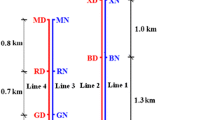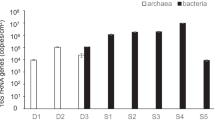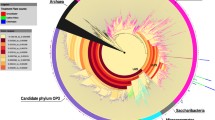Abstract
It is known that both disinfection and water quality can influence the bacterial communities in a drinking water distribution system (DWDS). Here, we hypothesized that bacterial communities in a DWDS with untreated groundwater with no prior purification and disinfection might differ from those in a DWDS with disinfected surface water. The present study applied Illumina MiSeq sequencing to investigate biofilm and planktonic bacterial communities in a DWDS fed with untreated groundwater (receiving no prior purification and disinfection). Considerable differences in bacterial richness (Chao1 richness estimator: 389–745 for water and 392–485 for biofilm), diversity (Shannon diversity index: 2.70–3.77 for water and 2.53–3.66 for biofilm) and community structure existed among both DWDS waters and biofilms. Biofilm and planktonic bacterial communities had distinct structures. The service time of DWDS could affect biofilm bacterial richness, diversity and community structure. Moreover, planktonic bacterial diversity and community structure might be influenced by NO2− concentration, while planktonic bacterial richness was related to NO3− concentration. Proteobacteria dominated in both biofilm and planktonic bacterial communities. Higher concentrations of NO2− favored the deltaproteobacterial proportion, but lowered the gammaproteobacterial proportion in drinking water. Overall, our study indicates that bacterial communities in a DWDS could be influenced by a variety of factors, such as habitats (water or biofilm), DWDS service time, and water chemistry.




Similar content being viewed by others
References
Berry D, Xi CW, Raskin L (2006) Microbial ecology of drinking water distribution systems. Curr Opin Biotechnol 17:297–302
Caporaso JG, Kuczynski J, Stombaugh J, Bittinger K, Bushman FD, Costello EK, Fierer N, Pena AG, Goodrich JK, Gordon JI, Huttley GA, Kelley ST, Knights D, Koenig JE, Ley RE, Lozupone CA, McDonald D, Muegge BD, Pirrung M, Reeder J, Sevinsky JR, Turnbaugh PJ, Walters WA, Widmann J, Yatsunenko T, Zaneveld J, Knight R (2010) QIIME allows analysis of high-throughput community sequencing data. Nat Methods 7:335–336
Douterelo I, Sharpe RL, Boxall JB (2013) Influence of hydraulic regimes on bacterial community structure and composition in an experimental drinking water distribution system. Water Res 47:503–516
Douterelo I, Jackson M, Solomon C, Boxall J (2016) Microbial analysis of in situ biofilm formation in drinking water distribution systems: implications for monitoring and control of drinking water quality. Appl Microbiol Biotechnol 100:3301–3311
Douterelo I, Jackson M, Solomon C, Boxall J (2017) Spatial and temporal analogies in microbial communities in natural drinking water biofilms. Sci Total Environ 581:277–288
Edgar RC (2013) UPARSE, highly accurate OTU sequences from microbial amplicon reads. Nat Methods 10:996
Edgar RC, Haas BJ, Clemente JC, Quince C, Knight R (2011) UCHIME improves sensitivity and speed of chimera detection. Bioinformatics 27:2194–2200
Flemming HC (2002) Biofouling in water systems-cases, causes and countermeasures. Appl Microbiol Biotechnol 59:629–640
Hong PY, Hwang CC, Ling FQ, Andersen GL, LeChevallier MW, Liu WT (2010) Pyrosequencing analysis of bacterial biofilm communities in water meters of a drinking water distribution system. Appl Environ Microbiol 76:5631–5635
Hu J, Dong HY, Xu Q, Ling WC, Qu JH, Qiang ZM (2018) Impacts of water quality on the corrosion of cast iron pipes for water distribution and proposed source water switch strategy. Water Res 129:428–435
Krishna KCB, Sathasivan A, Ginige MP (2013) Microbial community changes with decaying chloramine residuals in a lab-scale system. Water Res 47:4666–4679
Li XX, Wang HB, Zhang Y, Hu C, Yang M (2014) Characterization of the bacterial communities and iron corrosion scales in drinking groundwater distribution systems with chlorine/chloramine. Int Biodeterior Biodegrad 96:71–79
Li WY, Wang F, Zhang JP, Qiao Y, Xu C, Liu Y, Qian L, Li WM, Dong BZ (2016) Community shift of biofilms developed in a full-scale drinking water distribution system switching from different water sources. Sci Total Environ 544:499–506
Lin WF, Yu ZS, Chen X, Liu RY, Zhang HX (2013) Molecular characterization of natural biofilms from household taps with different materials, PVC, stainless steel, and cast iron in drinking water distribution system. Appl Microbiol Biotechnol 97:8393–8401
Liu RY, Yu ZS, Guo HG, Liu MM, Zhang HX, Yang M (2012) Pyrosequencing analysis of eukaryotic and bacterial communities in faucet biofilms. Sci Total Environ 435:124–131
Liu G, Verberk JQJC, Van Dijk JC (2013) Bacteriology of drinking water distribution systems, an integral and multidimensional review. Appl Microbiol Biotechnol 97:9265–9276
Liu RY, Zhu JG, Yu ZS, Joshi D, Zhang HX, Lin WF, Yang M (2014a) Molecular analysis of long-term biofilm formation on PVC and cast iron surfaces in drinking water distribution system. J Environ Sci 26:865–874
Liu G, Bakker GL, Li S, Vreeburg JHG, Verberk JQJC, Medema GJ, Liu WT, Van Dijk JC (2014b) Pyrosequencing reveals bacterial communities in unchlorinated drinking water distribution system, an integral study of bulk water, suspended solids, loose deposits, and pipe wall biofilm. Environ Sci Technol 48:5467–5476
Lu PP, Chen C, Wang QF, Wang Z, Zhang XJ, Xie SG (2013) Phylogenetic diversity of microbial communities in real drinking water distribution systems. Biotechnol Bioprocess Eng 18:119–124
Luhrig K, Canback B, Paul CJ, Johansson T, Persson KM, Radstrom P (2015) Bacterial community analysis of drinking water biofilms in Southern Sweden. Microb Environ 30:99–107
Magoc T, Salzberg S (2011) FLASH: Fast length adjustment of short reads to improve genome assemblies. Bioinformatics 27:2957–2963
Martiny AC, Jorgensen TM, Albrechtsen HJ, Arvin E, Molin S (2003) Long-term succession of structure and diversity of a biofilm formed in a model drinking water distribution system. Appl Environ Microbiol 69:6899–6907
McCoy ST, VanBriesen JM (2014) Comparing spatial and temporal diversity of bacteria in a chlorinated drinking water distribution system. Environ Eng Sci 31:32–41
Mi ZL, Dai Y, Xie SG, Chen C, Zhang XJ (2015) Impact of disinfection on drinking water biofilm bacterial community. J Environ Sci 37:200–205
Nagymate Z, Homonnay ZG, Marialigeti K (2016) Investigation of archaeal and bacterial community structure of five different small drinking water networks with special regard to the nitrifying microorganisms. Microbiol Res 188:80–89
Quast C, Pruesse E, Yilmaz P, Gerken J, Schweer T, Yarza P, Peplies J, Glockner FO (2013) The SILVA ribosomal RNA gene database project, improved data processing and web-based tools. Nucl Acid Res 41:D590–D596
Revetta RP, Gomez-Alvarez V, Gerke TL, Domingo JW, Ashbolt NJ (2016) Changes in bacterial composition of biofilm in a metropolitan drinking water distribution system. J Appl Microbiol 121:294–305
Roeder RS, Lenz J, Tarne P, Gebel J, Exner M, Szewzyk U (2010) Long-term effects of disinfectants on the community composition of drinking water biofilms. Int J Hygiene Environ Health 213:183–189
Stanish LF, Hull NM, Robertson CE, Harris JK, Stevens MJ, Spear JR, Pace NR (2016) Factors influencing bacterial diversity and community composition in municipal drinking waters in the Ohio River Basin, USA. PLos One 11:e0157966
Sun HF, Shi BY, Bai YH, Wang DS (2014) Bacterial community of biofilms developed under different water supply conditions in a distribution system. Sci Total Environ 472:99–107
Wang H, Masters S, Edwards MA, Falkinham JO, Pruden A (2014a) Effect of disinfectant, water age, and pipe materials on bacterial and eukaryotic community structure in drinking water biofilm. Environ Sci Technol 48:1426–1435
Wang H, Proctor CR, Edwards MA, Pryor M, Domingo JWS, Ryu H, Camper AK, Olson A, Pruden A (2014b) Microbial community response to chlorine conversion in a chloraminated drinking water distribution system. Environ Sci Technol 48:10624–10633
Wang Z, Yang YY, He T, Xie SG (2015) Change of microbial community structure and functional gene abundance in nonylphenol-degrading sediment. Appl Microbiol Biotechnol 99:3259–3268
Wu HT, Zhang JX, Mi ZL, Xie SG, Chen C, Zhang XJ (2015) Biofilm bacterial communities in urban drinking water distribution systems transporting waters with different purification strategies. Appl Microbiol Biotechnol 99:1947–1955
Xiong JB, Liu YQ, Lin XG, Zhang HY, Zeng J, Hou JZ, Yang YP, Yao TD, Knight R, Chu HY (2012) Geographic distance and pH drive bacterial distribution in alkaline lake sediments across Tibetan Plateau. Environ Microbiol 14:SI 2457–2466
Zhang JX, Yang YY, Zhao L, Li YZ, Xie SG, Liu Y (2015) Distribution of sediment bacterial and archaeal communities in plateau freshwater lakes. Appl Microbiol Biotechnol 99:3291–3302
Funding
This research was supported by the National Water Major Project (Grant No. 2015ZX07402-002) and National Natural Science Foundation of China (Grant No. 21777079).
Author information
Authors and Affiliations
Corresponding authors
Ethics declarations
Conflict of interest
The authors declare that they have no competing interests.
Human and animal rights statement
This article does not contain any studies with human participants or animals performed by any of the authors.
Additional information
Communicated by Erko Stackebrandt.
Electronic supplementary material
Below is the link to the electronic supplementary material.
Rights and permissions
About this article
Cite this article
Chen, J., Li, N., Xie, S. et al. Biofilm and planktonic bacterial communities in a drinking water distribution system supplied with untreated groundwater. Arch Microbiol 200, 1323–1331 (2018). https://doi.org/10.1007/s00203-018-1546-7
Received:
Revised:
Accepted:
Published:
Issue Date:
DOI: https://doi.org/10.1007/s00203-018-1546-7




